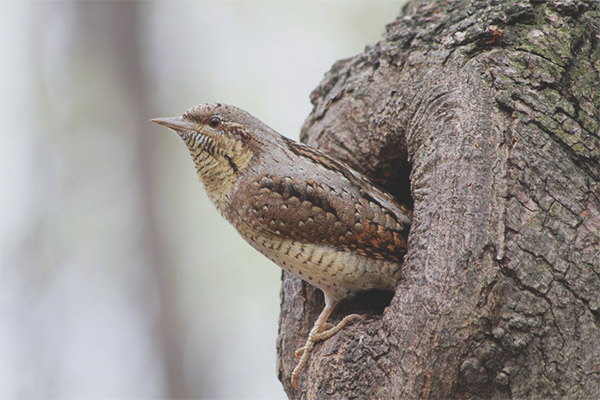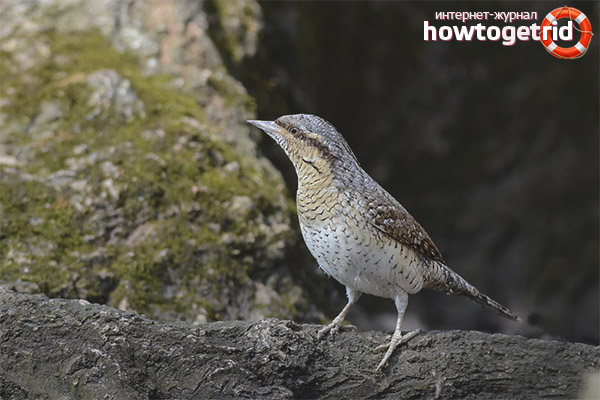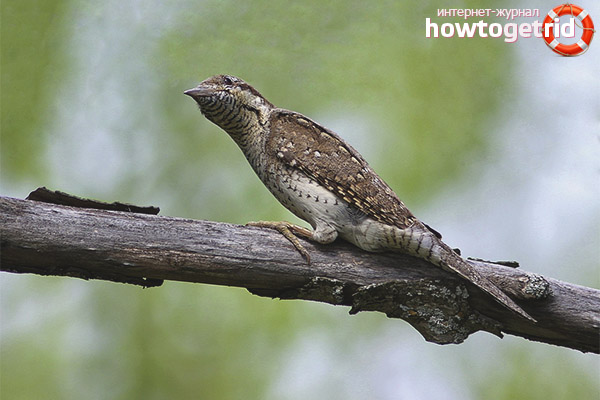The content of the article
Vertices are called small birds that are directly related to the woodpecker family, they are well known in Eurasia and in Africa. Their characteristic feature is the disproportionate size of the head and a very long tongue with which these birds can extract insects from the trunk of a tree. They have a short beak and a long tail, no different stiffness.
Description
The body length of an adult individual reaches 20 centimeters, and its weight reaches 48 grams. The coloring of the plumage of the male and female practically does not have differences, it consists of camouflage tones, which allow to mask on the background of the bark of trees.
The back of the crown has a variegated color, on a gray-brown background one can see elongated dark spots, which in some individuals may become sticking together. On their abdomen is a whitish plumage, having a transverse structure of the pattern.On the head of this bird there are characteristic black stripes, one starts at the beak and, passing through the eye, bends along the neck, and the second originates at the crown of the vertishisk and descends on the back of the head.
The front part of the neck of this bird, as well as the breast area, is covered with feathering of an ocher or yellowish tone. Her eyes have a dark brown color, and the dull color of the paws and beak consists of a brownish tint. Juveniles are similar in color to adults, only the structure of the pattern of their dress has more blurry forms.
The crown has a tail that looks like a woodpecker's tail, but its end has a rounding and it is not distinguished by its rigidity, therefore it is not suitable as a support in flight.
Diet
In the warm season, when the little bells are busy breeding offspring, the main food for them is various ants, for example, sod, earthen yellow or forest red, and they can also be different types of lazius or formica.These birds are more interested not in the ants themselves, as their larvae or pupae. Of course, in addition to ants, birds are interested in any other insects that can be found on a tree. It may be aphid, various caterpillars or beetles, but the vertexis diet is not limited to insects alone, they definitely will not give up fruits or berries.
It is curious that during the search for food the verticests are oriented towards bright colors, which is why in their stomachs often there are not edible objects at all, they can easily bite with foil of bright color with plastic or chips of non-ferrous metals.
Habitats
On the African continent, birds of this species are widely distributed in Algeria and in Tunisia, in addition, they can be found on the shores of the Mediterranean Sea. In the expanses of Eurasia, this bird can be found in the area of forests, from the coasts of the Iberian Peninsula and the western part of France to the eastern suburbs, the Kolyma riverbed, the island of Sakhalin, the Kuril archipelago and Japan.
Of all the species of woodpeckers living in the territory of Europe, only the topcoat is located for seasonal flights.And only some populations that chose the African continent as their habitat prefer to stay sedentary. Birds of this species, which have chosen the permanent habitat of their space, located from the sea coasts of the Mediterranean, to the mountains in the central part of Asia, migrate over short distances. All other wormholes prefer long-range seasonal flights.
Thus, in the winter time, the cusp can be found in many parts of the African continent, located south of the Sahara. They fly to Senegal and the Gambia, as well as to Sierra León and Ethiopia. In addition, they can be found in the Congo and Cameroon. Populations living in Siberia or in regions of the Far East prefer to winter in India, as well as in south-eastern Asia.
When it comes time to build nests, they prefer to settle in sparse deciduous forests or plantings; they can also be arranged by mixed forest areas. Birds are attracted to aspens, birches and lindens, forest glades, glades or forest margins are more suitable for them, forest lines located on the fields or coast of water bodies can still be used.
Vertishishek is not at all confused by the close proximity to a person, so they can often be seen on the territory of settlements, in various gardens, park areas and in areas of the private sector. Not considered habitable, they consider open steppe spaces.
The period of breeding offspring
Birds of this species create new pairs with each coming spring. From the warm edges, where they spend the winter period of time, the birds return, as a rule, in no hurry. In places of nesting they can be noticed only by the end of April, the beginning of May. For the nest, these birds are looking for secluded places in the form of cavities of rotten trees or thick branches, and an empty hollow can come up, as long as the location is not less than 3 meters from the soil level.
The beak of the wrist does not differ in its power, so they cannot knock out the hollow themselves. Not infrequently, they manage to choose suitable loopholes in the construction of outbuildings or summer cottages; a birdhouse can be a good solution for them. In a difficult situation, the code for a suitable place to build a nest for a long time can not be found, vertysheyki able to challenge your favorite place with other birds.
Smaller birds such as the gray flycatcher or the redstart are not rarely affected by this aggressive manner of behavior; But aggressive invaders sometimes themselves become victims of eviction, motley, as well as Syrian woodpeckers are able to shift them.
The choice of a place to build a nest is the privilege of the male, he approaches this issue with full responsibility, and when the choice is made, he sits down nearby and with the help of his voice, insistently calls on her friend until she appears. The flown female assesses the find of her gentleman, after which mating occurs. They do not burden themselves with such worries as building a nest of the crown; the female lays her laying just in the wood dust. At best, the nest remaining from the previous owners will be used.
The female Verticeisk postpones clutch from the last decade of May to the first half of June, sometimes she manages to make two clutches per season. Usually it is from 7 to 10 eggs, although in rare cases there may be 14, they are almost white in light color. If, as a result of tragic circumstances, the clutch is lost, the female has the ability to postpone it again.
The female debugs its laying with one egg per day, and it begins to hatch when the penultimate egg is laid, the incubation period is approximately 2 weeks. The female is mainly incubating eggs, but from time to time the male substitutes it for a short time. In the light of the small chicks appear alternately, they occupy the position, turning the beak to the center, creating a common figure in the form of a pyramid.
Singing features
This species of birds is engaged in singing only in the mating season, it resembles a loud chatter, made up of high sounds. The male, having found a suitable hollow, settles near him and begins to call on the female, making repetitive and uniform sounds, one trill can consist of 15–18 repetitions. The incoming female answers him in a similar way, in a duet they do not perform their marriage song.
There are cases when the male fails to shout to the female, being in this situation, he throws his find and tries again in another place. In alarming cases, these birds express their anxiety with a soft ticking or thin jerky squeaking.
Video: Vertices (Jynx torquilla)













To send